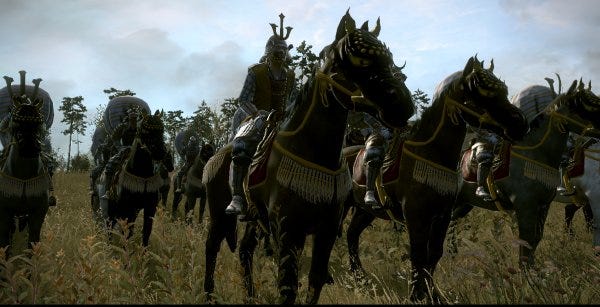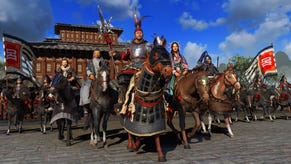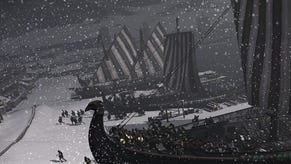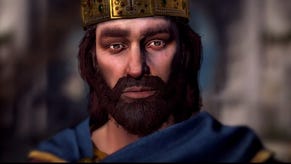Wot I Think: Total War: Shogun 2
Shogun 2 is set to be released on the 15th of March. For the past week I've been playing the single-player campaign, and I've written up my thoughts on this below. What I haven't done is play any of the multi-player. While Sega did provide a multi-player test for press and other interested parties, I don't really see the point of talking about it until there's a live service. That should, all being well, arrive with the game's launch on the 15th. We'll take a look at it after that time.
So then: how do I get busy with that shogunate?
Let's start at the beginning. THE BEGINNING OF TIME. Actually, the beginning of Total War will probably suffice. 2000's Shogun was what started it: a two tier strategy game set in ancient Japan. The turn-based campaign map saw you moving armies about between provinces, in a mild Risk type game of unit-production and army-positioning, while the battles between armies could be fought in real-time on a 3D map. This has set the template for the series and, despite colossal movement in all kinds of directions, this structure remains largely the same in 2011.
The Total War games are not interesting because they are tightly-honed, rule-governed systems, as many RTS games aim to be. They can't be said to be interesting because they are perfectly balanced, or cleverly structured in terms of progress over time. Nor are they interesting because they represent any kind of state of the art in technology. They are interesting because they represent a kind of exploratory simulation: what might it be like to govern in era x, and what can you do with a limited set of military, economic and diplomatic tools. While the Total War games take history as their inspiration, they are a counter-factual, and an abstract take on the processes of history. They are a big “What If” that allows you to play with war in unlikely situations, and see what might happen if Denmark had been a ruthlessly aggressive power throughout the Middle Ages.

The issue with this wide-open, sandbox approach to strategy was that when it gets too big, then things start to become messy. Empire was arguably a step too far, and consequently everything suffered. Shogun 2 is a step back, and everything has benefited. Because of the tighter focus on the single island of Japan, and the more comprehensible mechanics of spears, swords, horses, archers and not too much in the way of gunpowder-based conflict, the game is better encapsulated, and a purer Total War experience. Sadly that means it is also far less interesting than Empire as an experience. While flawed, Empire was at least braving new ground, and its scope was titanic. I've enjoyed Shogun a great deal, but I am nevertheless filled with a kind of longing for Empire's silly, all-encompassing vision. Sure, the release was buggy and it took months to be patched into happiness, but it was nevertheless something a little different. Shogun 2's ambitions are much closer, much more in line with the previous games, and as a result it feels overly familiar. If you have played every Total War game, then nothing here will surprise you too much, and if you require novelty, then that might just be a problem.
So then: to the heart of the beast. First up it's worth taking about the presentation of Shogun 2. This is possibly the most gorgeously a strategy game has ever unfurled its banners. Everything in every aspect of the game is exquisite. Partly this is because the Japanese theme makes for great design, while our Western medieval iconography seems a bit kitsch by comparison. The menus, the mist on the hills of the battle-maps, the aggressive bark of the ninja, the calligraphic UI elements, it all unites into one of the most rich and delicious experiences in gaming.
Choose a clan, and you can begin your struggle for dominance in the Sengoku period of Japanese history. The Tokugawa won in real life, but you can change that. You start off on the campaign map and you get your first taste of the of the aesthetics with the typically thorough clan presentation and follow up tips. The tips are generally explained to you by a wife or geisha woman, in quiet but insistent tones. Like all the voice-acting in the game, it's well pitched. The battle-maps' reports from livid and disgusted lackeys (“A SHAMEFUL DISPLAY!”) are a highlight, but it's all consistent and strong.

The map itself is laid out as if on parchment where it is outside your visual range, and as you explore this it rises up into 3D, returning to the blackness of a fog of war when you don't have a unit in the territory. The map becomes busy as the - very busy – as the game escalates. Again each region has a couple of outlying points, usually a port and a secondary village, which can be upgraded separately to the main castle settlement, and can also be attacked and damaged by raiding armies.
Development of your regions relies on two things. One, of course, is income, which can be modified in a number of ways – through developing farmland, developing road infrastructure, and developing sea trade (a simplified version of Empire's trade routes) – and then through the mastery of the arts. The arts consistent in what are essentially two talent trees, one more martial, the other more domestic. Skills on this tree take a certain number of turns to develop, and their development will often by tied to clan goals, for which you will be rewarded. Of course the clan you've chosen will also have some basic bonuses, and have a weaker or stronger starting position, and this will have some influence on the arts you intend to master. Since you can only work on one at any particular time, and you will need certain arts to unlock particular vital technologies, deciding what to work can be crucial to early success. The turn-based progression here always creates some oddness, and I found myself hammering through turns to get to the skill I needed to expand.
That early success can be hard in any game played above the normal difficulty setting. I didn't find “normal” to be too much of a challenge, but it was enjoyably tense thanks to pesky Christian rebels keeping me on my toes on the campaign map. I was able to win several battles against serious odds vs normal battle AI, which eventually seemed boring. Hard, however, was a little different. In anything over that the easiest starting positions I found myself getting seriously hammered in the early game, and it took some real grit and a bunch of replays to make progress. The campaign map difficulty does seem to be quite something, and I can scarcely imagine how impossible the top tier “legendary” difficulty must be. Surviving more than a couple of years must become the ambition at that level. The battle AI... well let's come to that in a moment.

Surviving at any level seems to hinge on your honour. The honour of the Daimyo (clan leader) pretty much dictates your ability to work through alliances with other AI leaders, and dishonour (generated by attacking an ally, leaving disloyal generals alive, or becoming Christian) can have other ramifications within your own provinces. Remaining honourable is – as you can imagine in game designed around aggressive expansion – tricky. But so is staying afloat without some serious bargaining with the other clans, who are inclined to team up against you if you're looking too much like or threat, or even the slightest bit like an easy target.
Agents too have a distinct and important role, too, although I admit that found the aggressive ninja to be far less use that others, such as a metsuke and monk, who have a positive effect in controlling your own territories. Offensive actions are relatively easy to come by and master, but a rebel army springing up in a lightly defended region is far more dangerous than any clan, when you've got your big armies at the frontiers of your realm. Keeping things together in a larger empire is also crucial when the current shogun finally decides to call you as the big enemy. This happens about half way into the campaign, and sees the other clans align with the Shogun against you. It's a good halt for any military momentum you might have built up. Where you might have been able to flatten the map in other Total War games, here you necessarily run into a greater challenge.
So then. That battle AI. At easy and normal I didn't find it to be any real challenge. Larger armies were easily convinced into entering my traps, and would blindly charge my forces entrenched on higher ground. Cavalry thought it was okay to run headlong into spearmen, and so on. On hard they are rather more cautious, and more likely to flank you effectively. Not that it always works – baiting with weaker units still means you can often draw off cavalry, although they will almost always avoid being drawn into a dangerous position versus missile units. Hard difficulty and higher on the battle AI seems to mean the enemy forces simply put on a more effective display, with missile units retreating to higher ground, and units selecting an appropriate target to attack – although I have yet to see them properly move behind other infantry for protection. I suspect the limited number of units is part of what makes the AI more consistent, but it is also the careful use of cavalry. The hard AI does seem comfortable the kind of harrying and attacking from the sidelines that these units need to undertake. Additionally, you won't encounter too much in the way of artillery (although there are plenty of siege weapons and such), and although firearms are present, the game leans less on simulating them, and more on pushing you towards melee.

Combat on the field is extremely pacey, too, with units covering ground quickly and rapidly resolving their fights. I had to use pause more than I usually do to keep track of actions in the larger battles.
Sieges – which I was a bit worried about at the preview stage – actually seem pretty tidy, too. The earthwork basis of the castles means that any infantry unit can, pretty much, climb the walls of your castle, and this means there's always a straight way in for any siege. It also means that as an attacker you can always come at the fort from several directions and often outwit the AI into not defending all its flanks. That said, it can do the same to you when you are defending. I was even surprised to see an enemy general dismount his cavalry and climb up to get inside and finish off my decimated defenders on a map I assumed I had won. Because the castles are much more open, much of the fighting is actually within the grounds. While you can hold the “battlements” such as they are, they don't sit atop a wall like Western fortifications, and once you're up the wall you're back on a battlefield. Ultimately, I began to rather enjoy sieges, which had been something I'd begun to avoid entirely – auto-resolving all the way – in the previous games.
Oh, and naval invasions are working, too.
Speaking of naval stuff – the battles at sea are rather lovely, both in terms of being visually splendid and far easier to deal with than the Empire battles, but I couldn't help feeling that the nuance of land battles was missing. With a larger force, and more missile boats, I would always win. I never really developed tactics in any meaningful way. At least with big sailships you know you needed to bring a big broadside as often as possible, here it's a bit more like driving tanks in a more basic RTS. There wasn't a lot more to it than that. It feels like these are really just in there for colour, and so I just built a large fleet and auto-resolved my way to victory.

There is – at least for my personal tastes – an still imbalance in all this. I found the campaign map difficulty pleasingly yielding on normal, with the battle maps being far too easy. I'd like to have been able to play on hard battle-map AI, and normal campaign AI. (In fact, wasn't that an option in previous Total War games? Because it's not an option here.) UPDATE: You can actually change battle difficulty in the options once the campaign has started. It feels like the game is tuned to someone else's difficulty tastes, which wasn't true of earlier instances of the series.
So, final words: a tight, coherent Total War offering. It's a bit of a system hog, I suspect. My God-like monster PC chuntered a bit on the very highest settings and the biggest battles, so although the game can look dreamy, I should imagine it's going to have to be scaled way back for the average gaming PC. Apparently the DX11 support is in a follow up patch in the coming weeks, too, and I should imagine there will be some bugs emerge in that time. I haven't found anything game-breaking (just a glitch or two), although some other press types are reporting occasional CTDs.
The game is out on the 15th, and there's no good reason not to buy it. I mean I guess there are reasons, as I've outlined, but anyway, just not good ones. You'll make your own mind up.

















